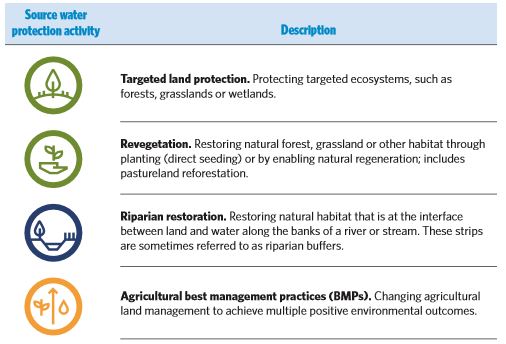Last August (time is flying) we posted a summary of the Specialty Coffee Association’s Blueprint for Water Security in the Coffeelands.
That paper presented 6 recommendations “to support action by coffee stakeholders committed to increasing water security at origin”. I want to highlight one of the key SCA recommendations, and how it links to an exciting new report on water security.
SCA Blueprint Recommendation 2#: Promote Water-Smart Farming Practices
This week, The Nature Conservancy (TNC) published a new report called, “Beyond the Source: the environmental, economic and community benefits of source water protection“. (Find the Executive Summary here).
“Beyond the Source” is based on analysis of 4,000 cities from around the world, and makes compelling cases for the need and the urgency to promote “nature-based solutions” for protecting and restoring water resources. Like SCA’s Blueprint, the title in TNC’s report “Beyond the Source” shows how sustainable land practices produce additional “co-benefits” beyond protecting water resources. As with the the work CRS promotes with Blue Harvest, sustainable agriculture management is good for both producing high quality farm products as well as “producing” water for downstream users.
“Beyond the Source” builds on similar work published by TNC in 2014, called the Urban Water Blueprint, which made the following conclusion:
“The greatest potential to secure water for cities lies in improving the management of agricultural lands… particularly in Latin America.”
The reason that improving management of agricultural lands is critical to water security, especially in Latin America, is because agriculture impacts such a large portion of watersheds. This includes the impact of coffee on watersheds at origin…as we highlight in this blog.
One thing that makes the TNC reports so important is that they represent an important shift in thinking. Historically, environmental groups saw agriculture as the problem, and the solution was to “rescue” land from farmers. In fact, that was a prominent part of TNC’s focus in past decades, when they would buy land from farmers, or pressure them legally to leave land. Needless to say, this created tension between TNC and farmers. It was Nature versus Farmers. Having grown up in California, that struggle was all the rage, from wetlands in the Delta, to grazing lands in the foothills of the Sierra’s, environmentalists were in constant battles with farmers over land management.
But over the past fifteen years – based on science, evidence and economics – there has been a shift to recognize that investing in “water-smart” agricultural practices often provides better returns on investments, including financial returns and environmental returns, than simply trying to preserve land. Environmentalists have reached this conclusion from one side. And farmers have reached the same conclusion from the their end. Both sides have learned to understand the “co-benefits” of “Best Management Practices” on agricultural lands. Below is an abbreviated list of “source water protection activities” that TNC highlights in “Beyond the Source”, which highlights BMPs.
TNC’s report should be seen as impetus for taking up the recommendations in SCA’s Blueprint, providing additional reasons for coffee stakeholders to explore ways to co-invest with local communities in sustainably managing water resources at origin.
— Paul Hicks @grok_water




